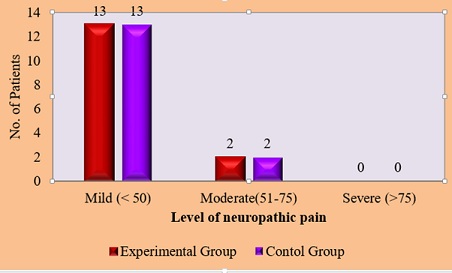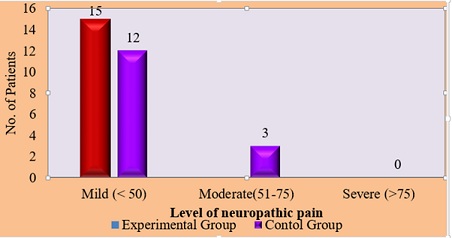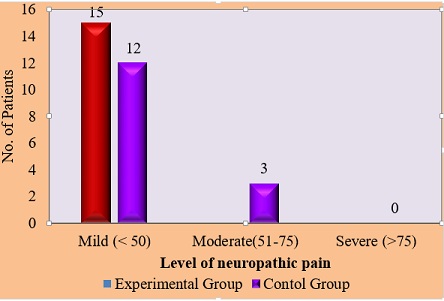
A Quasi Experimental Study to Evaluate the Effect of Contrast Bath Therapy on Neuropathic Pain among Diabetic Patients at a Selected Hospital
*Corresponding Author(s):
Gayathiri MCollege Of Nursing, SRIPMS, Coimbatore, India
Email:mukila.mm@gmail.com
Abstract
Diabetic Neuropathy is a condition in which the nerves are damaged due to diabetic micro vascular injury involving small blood vessels that supply nerves. A Quasi experimental study to evaluate the effect of Contrast bath therapy on neuropathic pain among diabetic patients. The main aim of the study was to assess the effect of contrast bath therapy on neuropathic pain among diabetic patients at Coimbatore. Non randomized quasi experimental pre-test post-test control group design was adopted in this study. By using purposive sampling technique, 30 samples were selected based on inclusion criteria, 15 in experimental and 15 in control group. The demographic variables, clinical profile of the samples were collected, the level of Neuropathic pain was assessed by Galer and Jensen neuropathic pain scale in both experimental and control group. Intervention was given to experimental group and routine treatment was given to control group. It was identified that the mean level of neuropathic pain among diabetic patient in the experimental and control group was 38.3 and 44.8 respectively with mean difference of 6.5. Likewise the standard deviation of the experimental and control group was 3.61 and 5.56 respectively. The calculated‘t’ value 3.549 was greater than the table value of 2.048 at 0.05 level of significance. Hence, it was concluded that contrast bath therapy is an effective method to reduce the neuropathic pain among diabetic patients.
Keywords
Contrast bath therapy; Diabetic patients; Neuropathic pain
Introduction
Diabetes mellitus is a metabolic diseases characterized by chronic hyperglycaemia resulting from defects in insulin secretion, insulin action, or both. Metabolic abnormalities in carbohydrates, lipids, and proteins result from the importance of insulin as an anabolic hormone. Therefore, Diabetes mellitus is a condition that occurs when the body can’t use glucose normally. Glucose is the main source of energy for the body’s cells. The levels of glucose in the blood are controlled by a hormone is called insulin, which is made by the pancreas [1]. Diabetes is certain to be one of the most challenging health problem in the 21st century. The International diabetes federation estimates that 425 million people worldwide have diabetes, it makes the largest global epidemic of the 21st century. 115 million people in china, 73 million in India and 30 million in the United States have diabetes. Diabetes is one of the most common non-communicable diseases globally. It is the fourth or fifth leading cause of death in most developed countries and that it is epidemic in many developing and newly industrialized nations. [2].
Diabetic peripheral neuropathy is a common chronic complication of diabetes mellitus. It leads to clinical complications such as foot ulceration, leg amputation, and neuropathic pain. Several novel diagnostic techniques are available which may supplement clinical assessment and aid the early detection of diabetic neuropathy. Glycaemic control in type 1 diabetes treat to reducing the risk of developing diabetic neuropathy. However, either glucose control or pathogenetic treatments are effective in painful-neuropathy and symptomatic treatments are often inadequate. The diagnostic techniques which may aid the early detection of diabetic neuropathy in the clinical and research environment [3].
Need for the study
Approximately 463 million adults (20-79 years) were living with diabetes in 2045 and this will rise to 700 million. The people with type 2 diabetes is increasing in most countries and 79% of adults with diabetes were living in low- and middle-income countries. A recent diabetic neuropathy survey in India, showed prevalence of diabetic neuropathy in Karnataka and Hyderabad was 12.9% and 16%. The total percentage of diabetic neuropathy was 19.78%, 16.06% in males and 22.04% in females of Karnataka and India. The overall weighted prevalence of diabetic neuropathy in Tamil Nadu was 10.4 %, Jharkhand 5.3%, Chandigarh, 13.6% and Maharashtra 8.4% [4]. The researcher identified that many patients who came with diabetic neuropathic pain among diabetic patients after five years of chronicity. Many studies have shown that diabetic neuropathic pain is one of the common symptom among diabetic patients. So the nurse felt that it is necessary to intervene the neuropathic pain among diabetic patients [5], performed a study to evaluate the efficacy of warm water foot bath among 60 patients with peripheral neuropathy at California. Quasi experimental design with simple random sampling technique was used. Samples were randomly selected and divided into three groups. The study results showed decrease in diabetic neuropathy score level in the warm and cold water therapy (t value of 15.06) was significantly decrease of pain level compared to group B and Group C [6], conducted a study to assess the effect of warm and cold food bath on neuropathic pain. Randomized clinical trial was used on 70 diabetic patients. Experimental group received warm and cold foot bath, it was administered for 8 sessions over 20 minutes every day, over 2 weeks. The data collection method was done by a questionnaire by interviewing and examination in three phases. Neuropathy scores were obtained as 7.24, 4.51, and 4.39 before the intervention, after two weeks post-intervention, and one month after the intervention [7], attempted a study to assess the effect of contrast bath therapy on superficial peroneal nerve function in lower limb among 29 diabetic neuropathic patients. After one week, the post test was done by structured questionnaire and neuropathic pain scale. Contrast bath therapy showed highly significant improvement in the nerve function in participants after giving the intervention for 4 weeks (‘t’=13.03, p=0.001) [8], conducted a study to assess the effectiveness of contrast bath on neuropathy pain among 60 clients with neuropathy pain among diabetic patients. The results showed that the post-test mean value of experimental group was 21.93 with standard deviation of 5.44 and mean value of control group was 72.73 with standard deviation of 7.15 and unpaired‘t’ value was 30.964 at p < 0.001
Statement of the Problem
A quasi experimental study to evaluate the effect of contrast bath therapy on neuropathic pain among diabetic patients at a selected hospital, Coimbatore.
- Objectives of the study
- To assess the level of neuropathic pain among diabetic patients.
- To find out the efficacy of contrast bath therapy on neuropathic pain among diabetic patients.
- To find out the association between neuropathic pain and selected demographic and clinical variables.
- Operational definition
Effect: It refers to the changes in the level of neuropathic pain among diabetic patients after contrast bath therapy which will be measured by Galer and Jensen neuropathic pain scale. Contrast bath therapy. It means that, is a physical therapy treatment in which all or part of the body is immersed first in hot water, the in cold water, and the procedure of alternating hot and cold is repeated several times.
Neuropathic pain: It refers to subjective feeling of neuropathic pain such as numbness, tingling sensation, cramps and increase sensitivity to touch due to chronicity of diabetic which will be measured using Galer and Jensen neuropathic pain scale.
Diabetic patients: Diabetic patients who have type I or type II diabetes for a duration of five years.
Hypothesis: There is a significant difference in the level of neuropathic pain after contrast bath therapy between the experimental and control group.
Assumption: Contrast bath therapy will reduced the level of neuropathic pain after the administration of intervention.
Methodology
- Research approach: Quantitative experimental research approach design was adopted for this study.
- Research setting: The study was conducted in all general ward, and special ward of Sri Ramakrishna hospital Coimbatore.
- Population: Diabetic patients with five years of chronicity.
- Sampling technique: Purposive sampling technique was adopted.
- Sample size: Total 30 patients were selected for this study.
Criteria for Sample Selection
- Inclusion criteria
- Patients with Type I or Type II diabetic patients with 5 years of chronicity.
- Patients who have good peripheral pulses in the lower extremities.
- Exclusion criteria
- Patients who have swelling in their leg, foot ulcers or gangrene and diabetic wound.
- Patients who have intolerance to cold/warm temperature.
- Patients with loss of sensation in the foot.
- Patient with gestational and juvenile diabetes, skin disorders, Thyroid disorder and Peripheral vascular Disease.
- Patients who underwent surgery in lower limb.
Data Collection Instruments
The tool consists
Section A: Demographic data: A questionnaire was designed to collect the demographic data age, gender, educational status, occupation, religion, marital status, type of family, personal habit and dietary habit.
Section B: Clinical profile of the sample: Clinical profile of the sample includes family history of diabetes, duration of diabetes mellitus, type of diabetic mellitus, treatment for diabetic mellitus, duration of neuropathic pain after diagnosis, Fasting Blood Glucose level (FBS) and HbA1c level are referred from secondary data.
Section C: Galer and Jensen neuropathic pain scale: This is a standardized tool which is developed by Galer and Jenson. This tool consists of 10 item questionnaire derived and has proven to be a valid and clinically useful device for screening and monitoring for neuropathic pain. The outcome of this tool measures about the neuropathic pain among diabetic patients.
Section D: Data collection procedure: Samples were selected based on inclusion and exclusion criteria. In experimental group, on the date of admission, pre-test was conducted by Galer and Jensen neuropathic pain scale for both experimental and control group. Along with routine treatment, contrast bath therapy was administered to experimental group (Hot water (100-105° F) for 3 minutes followed by cold water60-70° F) for 1 minute. It is repeated as three cycles, twice in a day. Post-test was collected on the date of discharge using Galer and Jensen neuropathic pain scale for both experimental and control group.
Data Analysis
Section I Demographic variables of diabetic patients with neuropathic pain.
Section II Clinical profile of diabetic patients with neuropathic pain.
Section III The level of neuropathic pain among diabetic patients.
Section IV Analysis on the effect of contrast bath therapy on neuropathic pain among diabetic patients.
Section V Association between the levels of neuropathic pain with selected variables among diabetic patients.
Demographic Data
Demographic data related to age, gender, educational status, occupation, religion, marital status, type of family, personal habit and dietary habit. Age groups of diabetic patients with neuropathic pain, majority in the experimental group 7 (46.7%) were between the age group of 51-60 years. In the control group, 12 (80%) were between the age group of above 60 years., gender patients were males in the experimental group 11 (73.3%) and control group 12 (80%) when compared to females. Religion majority of patients were Hindu in the experimental group 6 (40%) and control group 5 (33.4%). Educational status majority of the patients were high school in both experimental group 12 (80%) and control group13 (86.7%).The occupational status of the diabetic patients in the experimental group most of them were employed in both experimental group 13 (86.7%) and control group 9 (40%). Monthly income of the patients, majority of patients earned monthly income in experimental group 9 (60%) and control group 6(40%). Marital status of the patients, majority of patients were married in both the experimental 12 (80%) and control group12 (66.7%). Type of family, majority of patients were nuclear family 11(73.3%) in experimental group and 8 (53.3%) in control group. Personal habit, majority of patients were non-vegetarian in experimental group 14 (93.3%) and control group 13 (86.7%) and Dietary habit, majority of patients had no social habits of alcohol and smoking in experimental group 14 (93.3%) and control group13 (86.6%).
Clinical Profile Of The Sample
The Clinical profile of patients includes family history of diabetes, duration of diabetes mellitus, type of diabetic mellitus, treatment for diabetic mellitus, duration of neuropathic pain after diagnosis, fasting blood glucose level (FBS) and HbA1c.Results of the study shows that majority of them had family history of diabetes in experimental group 11(73.3%) and control group10 (66.7%). Duration of diabetic mellitus above five years in experimental group 13(86.7%) and control group14 (93.3%). Type II diabetes mellitus in experimental group 14(93.3%) and in control group15 (100%). Oral hypoglycaemic treatment for diabetic mellitus in the experimental group 11(73.3%) and in the control group 8 (53.3%). Duration of neuropathic pain patients had six months to one year of neuropathic pain in the experimental group 11 (73.3%) and in the control group 7 (46.7%), Fasting blood sugar patients had 100 -200 mg/dl fasting blood sugar level in experimental group 10 (66.7%) and control group 9 (60%) and HbA1c patients had 9.0mmol/L to 14.0mmol/L HbA1c level in experimental group 10 (66.7%) and 7.0mmol/L -8.0mmol/L HbA1c level in control group 9 (60%) (Figures 1-3).
 Figure 1: Pre-test level of neuropathic pain among diabetic patients in Experimental and Control group.
Figure 1: Pre-test level of neuropathic pain among diabetic patients in Experimental and Control group.
 Figure 2: Post-test level of neuropathic pain among diabetic patients in experimental and control group.
Figure 2: Post-test level of neuropathic pain among diabetic patients in experimental and control group.
 Figure 3: Level of Neuropathic pain.
Figure 3: Level of Neuropathic pain.
Student ‘t’ test was used to compare the effect of contrast bath therapy on post-test level of neuropathic pain among diabetic patients in experimental group and control group. It was identified that the mean level of neuropathic pain among diabetic patients in experimental group and control group was 38.3 and 44.8 respectively with a mean difference 6.5. Likewise the standard deviation of experimental and control group was 4.61 and 5.56 respectively. The calculated ‘t’ value 3.549 was greater than the table value of 2.048 at 0.05 level of significance. Hence the research hypothesis H2: “There is a significant difference in the level of neuropathic pain after the contrast bath therapy between the experimental and control group (Table 1).
|
S.No |
Study group |
Mean |
SD |
Mean difference |
Calculated ‘t’ value |
|
1
|
Experimental group |
38.3
|
3.61
|
6.5 |
3.549* |
|
2 |
Control group
|
44.8 |
5.56 |
Table 1: Diabetic patients in experimental group and control group.
Note: *Significant at 0.05 level.
The association between the levels of neuropathic pain with selected demographic and clinical variables among diabetic patients. It was found that chi-square value for demographic variables age (c²=0.0015), gender (c²=0.44), diet pattern (c²=0.01) and social habits (c²=0.0014) had no association with the level of neuropathic pain. Clinical variables duration of diabetic mellitus (c²=0), types of diabetic mellitus (c²=0), treatment for diabetes mellitus (c²=0.15), duration of neuropathic pain (c²=0.14), fasting blood sugar (c²=0) and HbA1c level (c²=0.13) had no association with the level of neuropathic pain among diabetic patients.
Conclusion
Diabetic neuropathic pain was found in diabetic patients after five years of occurrence. The presence of neuropathic pain was treated by glycaemic control or other alternative therapies. Contrast bath therapy is simple and non-pharmacological method. It is a series of brief, repeated immersions in water alternating between warm and cold temperature, it helps to reduce diabetic neuropathic pain and which has positive effects on treating neuropathic pain among diabetic patients. Thus they expressed a greater level of comfort and also assured that they will practice it regularly in their clinical and community settings.
References
- Bae JC, Cho NH, Kim JH, Hur KY, Jin S, et al. (2020) Association of body Mass index with the risk of incident type 2 Diabetes, crdiovascular disease, and all-cause mortality: A community-based prospective study. Endocrinology and Metabolism 35: 416-424.
- Callaghan BC, Gallagher G, Fridman V, Feldman EL (2020) Diabetic neuropathy: The future is promising. Diabetologia 63: 1951-1952.
- Raj P, Pitale S, Batra A, Gupta M, Singh R, et al. (2016) Abstracts. Endocrine Practice 23.
- Hamed E, Monem MA (2018) A review of diabetic peripheral neuropathy management given recent guidelines updates. Arch Gen Intern Med 2: 1-5.
- Sharma D, Kumar, K, Yadav N, Sharma L (2017) To compare the effect of different time ratio of heat and cold in contrast bath on clinical improvement in plantar fascitis. International Journal of Orthopaedics 3: 146-149.
- Farina F (2020) Effect of warm and cold foot bath reduce neuropathy pain. Indian journal of diabetic care 10.
- Pereira H, Singaravelan RM (2020) Effect of contrast bath therapy on superficial peroneal nerve function in diabetic neuropathy patients-an informal experimental study. International Journal of Science & Engineering Development Research 5: 385-392.
- Vishnu N (2020) Effectiveness of selected intervention on neuropathy pain among clients with diabetes mellitus patients at selected hospital in varanasi, uttarpradesh. International Journal of Research in Engineering, Science and Management 3: 2581-2592.
Citation: Gayathiri M, Deepa, Nirmala T (2022) A Quasi Experimental Study to Evaluate the Effect of Contrast Bath Therapy on Neuropathic Pain among Diabetic Patients at a Selected Hospital. J Diabetes Metab Disord 9: 041.
Copyright: © 2022 Gayathiri M, et al. This is an open-access article distributed under the terms of the Creative Commons Attribution License, which permits unrestricted use, distribution, and reproduction in any medium, provided the original author and source are credited.

